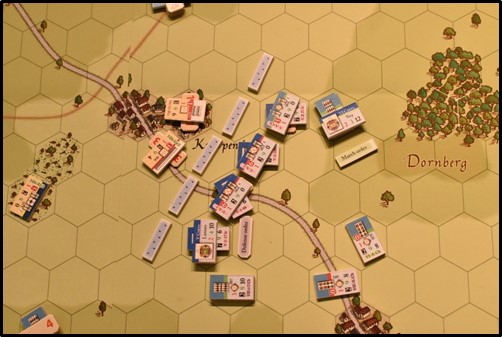8:00 French turn
With Lannes holding against the enemy counter-blows, the Saxon 4th Grenadiers had left themselves in a vulnerable situation – with their rear facing the impatient French light cavalry. At 8am, the 9th & 10th Hussars formed up into line in preparation for a charge. This was noticed by the 4th Grenadiers who with their high morale and good training quickly formed into square. The hussars, not willing to charge such a formation, called off their charge. However, the relief for the grenadiers was short lived as through the fog they saw several batteries of French guns unlimbering.
Lannes and the 17th Light Infantry were feeling exposed and with his corps on the brink of exhaustion after two hours of near persistent fighting he decided to pull back and form a defensive line. The Prussian guns to his front made every step of his retreat costly, in the now severely depleted ranks of the 17th Light Infantry. Along the rest of the French line, regiments changed from column to line, indicating to the Saxons that the initial French attack had run its course. South of Krippendorf, Saxon and French lines exchanged fire causing multiple casualties to both sides. The now unlimbered 1st & 2nd Artillery poured fire onto the Saxon infantry square; the square was quickly in full retreat.
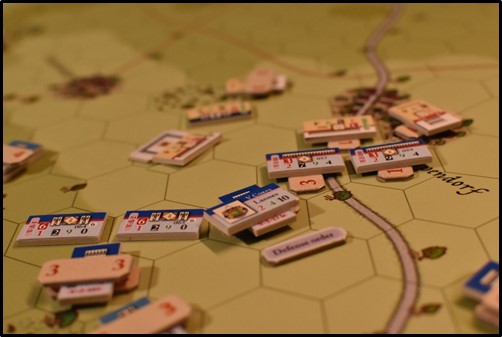
Just before the French artillery broke the Saxon square, which is just visible in the distance. The new French defensive line is to the right of the artillery.
The remainder of Ney’s infantry arrived and began march to the sound of the guns.
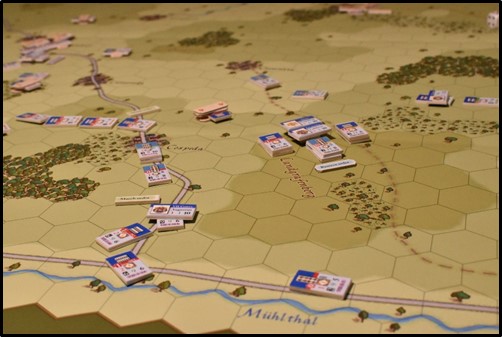
Soult, Ney and Augereau continued their march to their starting positions. Ney’s just arrived infantry are just off picture to the right.
The French horse artillery and 21st Light Infantry rallied back to good order.
The retreat of 17th Light Infantry pushed the Vth Corps to 9 fatigue (one more and the corps would suffer a -2 morale penalty). Each of the other French corps also gained a fatigue due to their movement.
8.00 Prussian Turn
By now sufficient reports had reached Hohenlohe that convinced him this was a significant French attack. He now had to face the difficulties of his command structure considering the flexibility that the French were demonstrating with their corps system. From the initial deployment it would seem obvious to send the 1st Division east and the 2nd Division to the south-west, however with the large wooded area in the centre separating his divisions this would very much stretch Hohenlohe’s 6 hex corps command radius to breaking point. This would not be a problem if he was considering a static defence, but the reports had got his blood up and he wished to tackle the French sooner rather than later before even more French arrive on the field. He therefore decided to send both the 1st and 2nd Divisions east and have Ruchel Corps, who can act with more independence operate to the south-east of Isserstedt. With all that under consideration, Hohenlohe issued the following orders:
Ruchel’s orders:
-
Primary order: Tactic: march. Objective: move to a position where the trail from Isserstedt meets the main Weimar-Jena road, deploy infantry to line when in position. Conditions: before contact is made deploy infantry to line.
-
Secondary order, if primary order succeeds: Tactic: Attack. Objective: drive back all enemies west of the road from Lutzeroda to Cospeda. Conditions: Do not launch attack until corps has recovered fully from the march (0 fatigue). Maintain a cavalry unit within charge range of Weimar-Jena road.
-
Secondary order, if primary fails: Tactic: defence. Objective: establish a defensive line in and south-west of Isserstedt. Conditions: none.
To Hohenlohe’s own forces he issued the following order:
Hohenlohe’s orders:
-
Primary order: Tactic: march/defensive. Objective: 1st Division move to east of Viezehnheiligen and adopt a defensive stance. 2nd Division move east and form up to the left of 1st Division. Units to change to line when units are in position. Conditions: Briefly rest forces before launching attack (fatigue no greater than 1).
-
Secondary order, if primary order succeeds: Tactic: Attack. Objective: take Krippendorf, Lutzeroda and the Dornberg hill. Conditions: Halt attack when units are fatigued (7+ morale).
-
Secondary order, if primary fails: Tactic: defense. Objective: establish defensive line along the Hermstedt-Viezehnheiligen-Isserstedt road. Conditions: none.
Hohenlohe spent no time riding to confront the impudent Corsican (by special scenario rule Hohenlohe can use all his movement points on the first turn despite being the army commander). None of his units began the turn in command and so there will be no advance for at least half an hour.
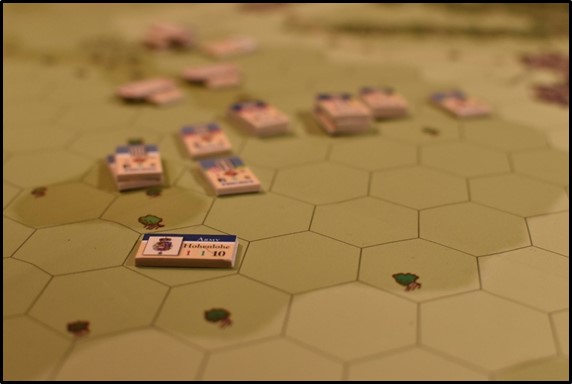
Hohenlohe wastes no time in joining the 1st and 2nd Divisions
Taunzien’s detachment was now in a bad way and little could be done but for the multitude of disordered troops but to continue to retreat, and the Saxons in and around Krippendorf to try and hold until relieved.
As Ruchel’s Corps was in command, due to Ruchel’s proximity, they immediately began their march to the south of Isserstedt, their movement still being hampered by the thick fog, although there were signs that it might shortly begin to lift. Ruchel’s Corps gained a fatigue.
Several Saxon and Prussian units rallied, including: 12th Line and 7th Hussars.
8:30 French turn
The fog began to thin, reducing the penalties for movement and artillery fire. Lannes initial attack had been successful apart from taking the village of Krippendorf. The 88th and 100th Infantry were still trading shots with the Saxon 3rd Grenadiers but elsewhere all was quiet. The other French forces continued their deployment and with the arrival of Soult’s 2nd Division the number of French soldiers on the field were increasing rapidly.
The period between 8:30am and 9am saw little action as the French moved their forces into position.
Lannes ordered the 88th & 100th Infantry to disengage, and the 88th lost many men whilst withdrawing from the 3rd Grenadiers. The corps artillery moved to join the 88th & 100th Infantry making sure there was space for the soon to arrive VIIth Corps of Augereau to deploy. Lannes Corps deployed a screen of voltigeurs to harry the Saxon grenadiers and hinder the fire from the distant Prussian artillery. The relocated French artillery and skirmishers fired at the 3rd Saxon Grenadiers who were holding the ground outside Krippendorf. Despite the grenadiers suffering many casualties and being reduced to a shadow of their former strength their stubbornly held their ground.
Lannes Vth Corps increased its fatigue by 1 to 10, they were now exhausted from two hours of very intense fighting in the fog (-2 on morale).
Soult arrived at his designated position and began to deploy his troops. Other French forces continued their march into position. All corps gained an additional fatigue.
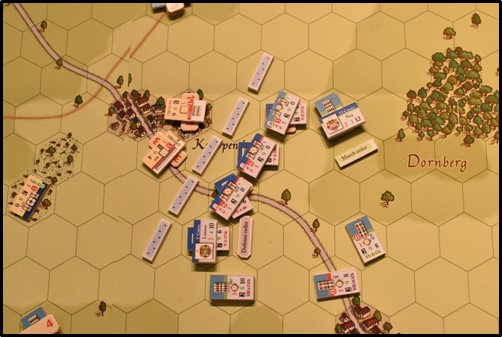
Lannes defensive line – the men are tired but there was no immediate threat from the Prussians. At the bottom of the picture you can see the lead cavalry of Augereau, and at the top Ney’s and his light cavalry arriving at the front.
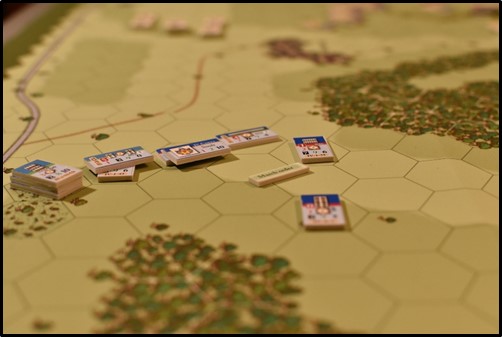
Soult began to deploy his forces near the Jena-Weimar road.
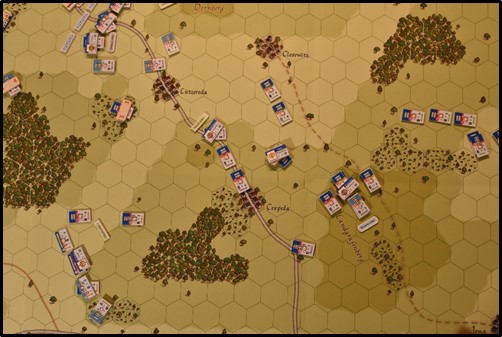
8:00am: French forces march to their deployment areas.
Napoleon, himself, rode down from the Landgrafenberg to have a stern word with the commander of the 34th infantry regiment who had broken and routed after being fired upon by Prussian guns earlier in the morning – Napoleon proved very persuasive and the unit rallied to good order…
8:30 Prussian turn
Finally, most of 1st & 2nd Divisions were in command and ready to join battle. Soult was surprised to see the Saxons who he assumed he would be fighting begin to move north, but quickly made out the Prussians of Ruchel’s Corps approaching his position.
Hohenlohe’s and Ruchel’s forces gained a fatigue.
